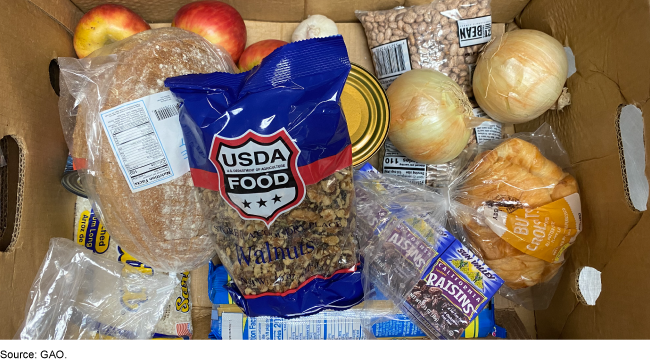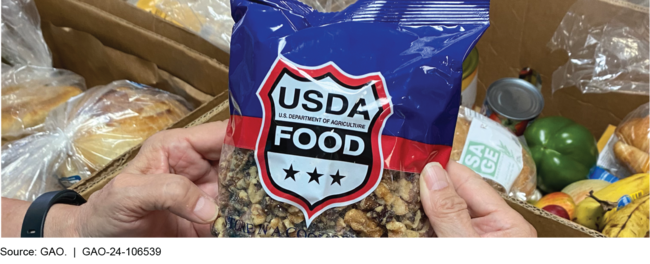Charitable Food Assistance: USDA Can Enhance Guidance and Improve Program Performance Assessment
Fast Facts
Two U.S. Department of Agriculture programs supply food banks and pantries that support seniors and families who struggle to afford groceries.
USDA oversees states that assist local groups operating these programs, often with volunteer help. However, it doesn't have user-friendly guidance for them, such as a handbook. We found more than 100 guidance documents across both programs.
In addition, the process for rejecting deliveries of spoiled food can hold trucks in place and clog facility loading docks.
Lastly, USDA hasn't set performance goals for these programs, so it's unclear how well they work.
Our recommendations address these issues.
Box of Food including Bag of USDA Food Walnuts for Food Pantry Distribution

Highlights
What GAO Found
The U.S. Department of Agriculture (USDA) has established three key indicators of food hardship: food security, food sufficiency, and use of community food. These indicators have various strengths and limitations, according to GAO analysis. For example, the indicator of food security has been validated and consistent over time and is considered the gold standard by experts. At the same time, the indicators do not provide insight on the causes of food hardship, nor were they designed to measure the effectiveness of federal nutrition assistance programs. Changes in food hardship could be due to many factors other than the performance of programs, such as fluctuations in the economy or in food prices.
Figure: Bag of USDA Foods Walnuts for Food Pantry Distribution

USDA's Food and Nutrition Service (FNS) oversees state implementation of The Emergency Food Assistance Program (TEFAP) and the Commodity Supplemental Food Program (CSFP), which together received about $2.8 billion in federal funding in fiscal year 2023. Specifically, FNS monitors state operations and provides written guidance, technical assistance, and information sharing. However, FNS regional officials reported that FNS does not provide consolidated and user-friendly guidance, such as a handbook, for states and local agencies that implement the programs. Instead, GAO searches on the FNS website identified 69 TEFAP and 46 CSFP guidance documents. In addition, local agencies GAO interviewed generally said they appreciated the food they received from TEFAP or CSFP, but FNS and state officials reported challenges addressing deliveries of spoiled or damaged food in a timely manner. Lack of a timely response can result in inefficiencies and tense interactions at food banks, according to officials. Improving guidance and implementing a streamlined process to address these food deliveries could help FNS better support states and local agencies in implementing these key nutrition assistance programs.
FNS has not established a program performance assessment system for TEFAP and CSFP. For example, while FNS has identified various priorities for these programs, it has not established measurable performance goals. As a result, it is difficult to assess progress or outcomes over time. While FNS has proposed to improve data collection, gaps in knowledge about the effectiveness of TEFAP and CSFP have persisted. A robust performance assessment system could put FNS in a better position to evaluate the effectiveness of these programs.
Why GAO Did This Study
Visits to food banks and food pantries to obtain free food increased substantially during the COVID-19 pandemic. Two USDA nutrition assistance programs—TEFAP and CSFP—rely on local agencies (such as food banks and food pantries) for their implementation. GAO was asked to review these programs.
This report examines (1) the strengths and limitations of federal indicators of food hardship, (2) the extent to which USDA oversees state implementation of TEFAP and CSFP, and (3) the extent to which USDA has assessed the performance and effectiveness of these programs.
GAO reviewed documentation and interviewed USDA officials, six selected experts, and two relevant national organizations. In addition, GAO selected three states to obtain variation in TEFAP and CSFP participation and other characteristics: Washington, D.C., New Mexico, and Montana. GAO visited and interviewed state officials responsible for administering the programs in these states and representatives from 14 selected food banks and food pantries. GAO also interviewed officials from a large independent food bank.
Recommendations
GAO is making five recommendations to USDA, including to provide consolidated, user-friendly program guidance; to streamline the process to resolve delivery issues and complaints; and to implement a program performance assessment system, beginning with setting measurable program performance goals. USDA concurred with the recommendations.
Recommendations for Executive Action
| Agency Affected | Recommendation | Status |
|---|---|---|
| Department of Agriculture | The Secretary of Agriculture should ensure that the Food and Nutrition Service document and implement a process to provide and routinely update consolidated and user-friendly TEFAP program guidance for states and local agencies on the FNS website. For example, this could be a program handbook or a consolidated list of pertinent program guidance. (Recommendation 1) |
USDA generally agreed with this recommendation. We will monitor the agency's efforts to implement it.
|
| Department of Agriculture | The Secretary of Agriculture should ensure that FNS document and implement a process to provide and routinely update consolidated and user-friendly CSFP program guidance for states and local agencies on the FNS website. For example, this could be a program handbook or a consolidated list of pertinent program guidance. (Recommendation 2) |
USDA generally agreed with this recommendation. We will monitor the agency's progress in implementing it.
|
| Department of Agriculture | The Secretary of Agriculture should ensure that FNS, in coordination with the Agricultural Marketing Service, document and implement a plan with measurable goals and timeframes to streamline the process for resolving USDA Foods delivery issues and complaints. This could include streamlining the escalation process for delivery issues and proactively communicating complaint status updates with recipient agencies. (Recommendation 3) |
USDA generally agreed with this recommendation. We will monitor the agency's efforts to address it.
|
| Department of Agriculture | The Secretary of Agriculture should ensure that FNS develop and implement a program performance assessment system for TEFAP, beginning with setting measurable program performance goals and measures. In developing goals and measures, FNS should consider the types of data and information that could be useful for future evaluations. (Recommendation 4) |
USDA generally agreed with this recommendation. The agency noted that it may need additional funding to collect data to support performance goals and measures for these programs. We will monitor the agency's progress to address this recommendation.
|
| Department of Agriculture | The Secretary of Agriculture should ensure that FNS develop and implement a program performance assessment system for CSFP, beginning with setting measurable program performance goals and measures. In developing goals and measures, FNS should consider the types of data and information that could be useful for future evaluations. (Recommendation 5) |
USDA generally agreed with this recommendation. We will monitor the agency's efforts to address this recommendation.
|
